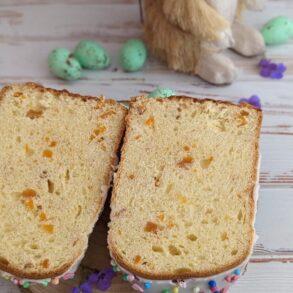
Kulich with quark
Thanks to the quark yeast dough, the Russian sweet Easter bread tastes heavenly moist and fluffy at the same time. Lemon zest gives it a special flavor. The quark Easter bread is also an eye-catcher on the dining table and perfect for giving as a gift at Easter. With this recipe you make the kulich with quark yourself.
Servings 2 Easter breads
Equipment
- Ø 12 cm large and 10 cm high kulich baking pan
- Ø 16 cm large and 12 cm high kulich baking pan
Ingredients
for the dough
- pre-dough
- 200 g quark (drain off liquid) room warm
- 200 g sugar**
- 100 g butter room warm
- 3 eggs room warm
- approx. 650 g flour**
- 70 g soft apricots
- 30 g candied orange peel
- 1/2 tsp. salt
- 1 pinch of vanilla bean**
- zest of 1 organic lemon
- vegetable oil for the hands if necessary
- butter for greasing the baking pans if necessary
- flour for dusting the baking pans if necessary
for the sugar icing
- 10 g butter
- 20 ml milk
- approx. 150 g powdered sugar
for decorating
- colored sugar sprinkles
Instructions
Preparation of the pre-dough
- Dissolve sugar and fresh yeast in lukewarm milk.
- Add flour and mix.
- Cover the dough and let it rise in a warm place for 20 minutes.
Preparation of the dough
- Beat eggs, sugar and salt to an airy light mass.
- Add softened butter, quark, lemon zest and vanilla and mix.
- Add the pre-dough and mix it.
- Add flour in batches and knead it into a very soft, sticky dough. Then knead the dough for about 12 - 15 minutes and let it rise, covered, in a warm place for 1 hour.
- Cut soft apricots into small pieces.
- Knead the soft apricots and candied orange peel into the dough either with kneading picks or with oiled hands.
- Let the dough rise, covered, in a warm place for another 30 minutes.
- Line the kulich baking pans completely with baking paper. Alternatively, you can grease the baking pans with butter and dust them with flour, tapping off the excess flour.
- Fill the kulich baking pans about 1/3 full with the dough and let them rise in a warm place for 30 minutes.
- Bake the kulichi in a preheated oven at 338 °F (170 °C) on the second rack from the bottom for about 40 - 50 minutes, depending on the size of the baking pan. If the surface of the kulichi becomes too brown before they are cooked, cover them with baking paper on top in the oven.
- Let the kulichi cool briefly in the baking pans, then carefully take them out, place them on their sides on a kitchen grate and let them cool, turning them over and over during this time.
Preparation of the sugar icing
- Heat milk together with butter until the butter is melted.
- Gradually add powdered sugar and mix until you have a white, glossy thick icing.
- Coat the top of the Easter breads with the sugar icing, sprinkle them with colorful sugar sprinkles and let the icing dry briefly.
Notes
- Drain the excess liquid from the quark, so that you do not need more flour than necessary.
- Instead of fresh yeast you can use dry yeast. For the recipe you need 9 g of it.
- The amount of flour given may vary. Add flour in portions to the other ingredients until you get a very soft, sticky dough.
- Instead of soft apricots and candied orange peel, you can use other dried or candied fruits.
- To bake the Russian Easter bread you need kulich baking pans. I used a baking pan about Ø 12 cm and 10 cm high and a baking dish about Ø 16 cm and 12 cm high.
- The stated baking time can vary greatly, depending on the sizes of the baking pans. My small kulitsch was ready in 40 minutes, the larger one in 50 minutes.
- Use a wooden skewer to check if the Easter bread is done baking.
- Note the detailed tips and tricks for making the kulich with quark at the top of the post.